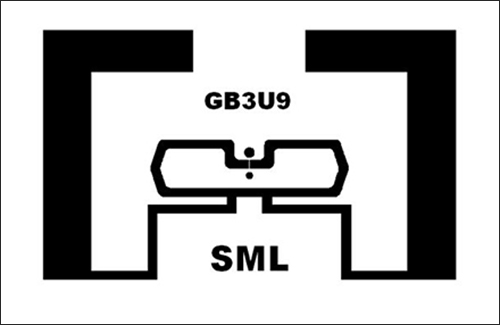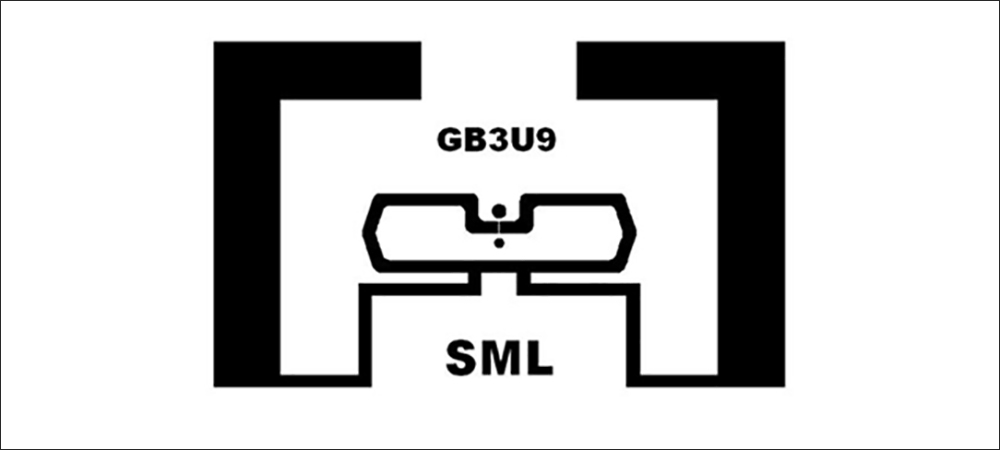While retailers are leveraging radio frequency identification technologies primarily at their stores for apparel and footwear tracking, SML‘s retailer customers have expressed a common goal to push item-level management further up the supply chain. With that in mind, the RFID solutions company says it is releasing products that enable more sensitive and reliable tag reads in challenging environments. The firm has launched a tag family that incorporates Impinj‘s M700 series chips to offer smaller, affordable tags for retailers.
Additionally, SML has released a new inlay that features greater sensitivity for tagged apparel and footwear being read at DCs as they make their way to stores and customers. The inlay, known as the GB3U9, is one of the first UHF RFID inlays certified for retail use by the University of Auburn RFID Lab, and it leverages NXP Semiconductors‘ UCODE 9 chip. It comes with antennas optimized for greater forward and reverse transmission, for receiving both interrogations from a reader and the response transmissions.

SML’s GB3U9 inlay
includes 3D orientation design for reading tags in challenging environments, including boxed goods moving through a portal on a full pallet, with various materials that include denim and poly bags, says Dean Frew, SML’s CTO and senior VP of RFID solutions. However, he notes, the inlays also provide some improved performance for use with handheld readers in stores, for the purpose of inventory counting.
NXP released its UCODE 9 chip last summer to provide greater read sensitivity at a longer range, and it targeted fast inventory capture in dense RFID tag environments. Companies have since begun building inlays that incorporate the chip. The GB3U9 inlay measures 50 millimeters by 30 millimeters (2 inches by 1.2 inches) and is designed to fit on a standard apparel price tag or sticker. Several of SML’s existing retailer customers are now planning to transition to the new tags.
“The message to end users,” Frew says, “is that you will really see the difference in supply chain applications where you have dense environments and speed.” That, for instance, means a box of tightly packed products (underwear, for example) can include several hundred RFID tags, which could be reliably read as the box moves down a conveyor or through a portal at high speed. That scenario has traditionally proved challenging for RFID, he explains, due to the tag density or materials that might be in a box with the tags, such as denim or poly bags.
Most supply chains are currently not outfitted with RFID technology. While some brands are applying tags to products at the point of manufacture, those tags are typically being read only once they are received at a store. However, there are potential benefits for both brands and retailers with regard to capturing tag data from goods between a factory and a store. For instance, companies can better manage supply and stocking if an automated system tracks where goods are located. In addition, omnichannel sales can enable the delivery of products directly from a DC to customers if information is being captured about goods onsite.

Dean Frew
Each retailer using SML’s solutions has an interest in supply chain item-level management, Frew says, adding, “It’s the natural progression of the technology.” In fact, RFID adoption in retail has been accelerating during the past few years. “We manage 200 million items a week on our software. That number continues to grow month to month, and a lot of those users continue to push RFID use up the supply chain.”
One hundred percent of SML’s retailer customers are seeking to push that process back to the point of manufacture, Frew reports. As that transition takes place, it will be phased in, with the first step often involving the deployment of readers to capture tags as they are received at distribution centers. Read accuracy is considerably more challenging in a DC environment than at stores, he notes. Tagged goods are shipped in a variety of forms, including on hangers, in boxes and stacked on pallets. “Anything we can do to help achieving high accuracy, that’s what we’re doing.”
The GB4U9 inlay provides marginal improvement in handheld read performance for those reading tags at stores, Frew says. That read sensitivity will be enhanced by new reader products which will be released in the coming months and years. “The technology is continuing to improve accuracy,” he states. For retailers, losing only a few RFID tags during inventory counts or at DCs can have costly results. “Every customer wants to get as accurate as possible. If I can get 98.9 percent instead of 95 percent, that’s significant.”
The new inlay has met Auburn University’s ARC categories for industry-wide performance requirements. While the college has tested the GB3U9 in its own laboratory chamber, Frew says, SML has been testing the inlay at its own lab environment in Plano, Texas. The GB3U9 will have the same price as predecessor inlays and is available now in high volumes. “So you have more performance for the same cost spent,” he states. Multiple companies are in the process of planning a transition to using the new inlay.
The inlay can be converted into an adhesive label or be built into an integrated price ticket, and it can also be used in a sewn-in tag form factor. The tag family based is intended to make RFID technology use more affordable, the company says, with tags that meet a variety of form-factor needs. The tags leverag Impinj’s smaller chip size in order to enable more compact inlays for use not only in retail, but in other industries as well.
SML has witnessed faster growth in RFID adoption year over year, Frew reports. Many companies operating thousands of stores have considerably fewer DCs, meaning the rollout of infrastructure is less than the volume of readers required at the retail sites themselves. This year, SML plans to provide multiple deployments in supply chains with its existing retail customers.
Other deployments have been under way for individual brands, including Hermann Kay (see Herman Kay Uses RFID to Track and Improve Garment Production) and Dickies (see Brands Track Shipping Accuracy via RFID), using SML’s FactoryCare solution to track the shipping of product through warehouses to downstream retailers. This has enabled the companies to reduce claims of mis-shipments.


